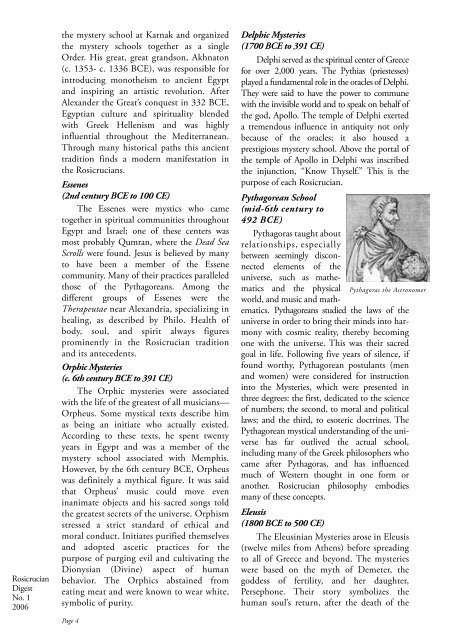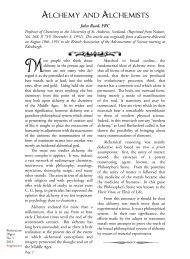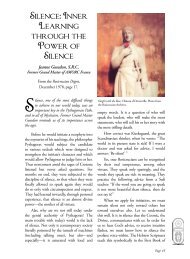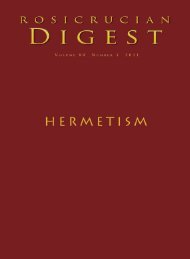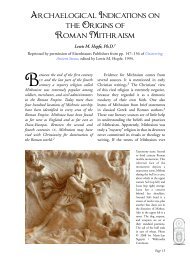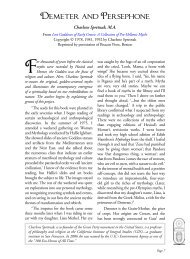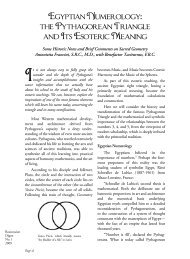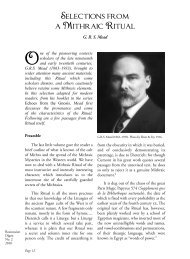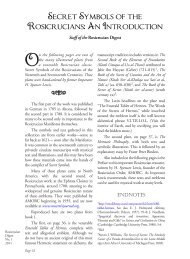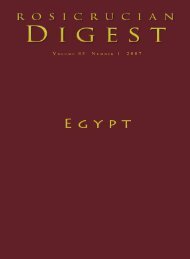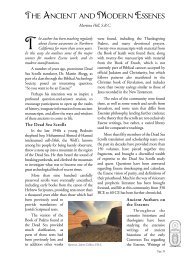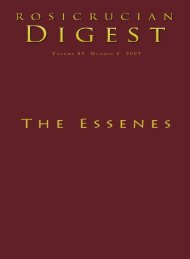The Grand Temple - Rosicrucian Order, AMORC
The Grand Temple - Rosicrucian Order, AMORC
The Grand Temple - Rosicrucian Order, AMORC
You also want an ePaper? Increase the reach of your titles
YUMPU automatically turns print PDFs into web optimized ePapers that Google loves.
<strong>Rosicrucian</strong><br />
Digest<br />
No. 1<br />
2006<br />
the mystery school at Karnak and organized<br />
the mystery schools together as a single<br />
<strong>Order</strong>. His great, great grandson, Akhnaton<br />
(c. 1353- c. 1336 BCE), was responsible for<br />
introducing monotheism to ancient Egypt<br />
and inspiring an artistic revolution. After<br />
Alexander the Great’s conquest in 332 BCE,<br />
Egyptian culture and spirituality blended<br />
with Greek Hellenism and was highly<br />
influential throughout the Mediterranean.<br />
Through many historical paths this ancient<br />
tradition finds a modern manifestation in<br />
the <strong>Rosicrucian</strong>s.<br />
Essenes<br />
(2nd century BCE to 100 CE)<br />
<strong>The</strong> Essenes were mystics who came<br />
together in spiritual communities throughout<br />
Egypt and Israel; one of these centers was<br />
most probably Qumran, where the Dead Sea<br />
Scrolls were found. Jesus is believed by many<br />
to have been a member of the Essene<br />
community. Many of their practices paralleled<br />
those of the Pythagoreans. Among the<br />
different groups of Essenes were the<br />
<strong>The</strong>rapeutae near Alexandria, specializing in<br />
healing, as described by Philo. Health of<br />
body, soul, and spirit always figures<br />
prominently in the <strong>Rosicrucian</strong> tradition<br />
and its antecedents.<br />
Orphic Mysteries<br />
(c. 6th century BCE to 391 CE)<br />
<strong>The</strong> Orphic mysteries were associated<br />
with the life of the greatest of all musicians—<br />
Orpheus. Some mystical texts describe him<br />
as being an initiate who actually existed.<br />
According to these texts, he spent twenty<br />
years in Egypt and was a member of the<br />
mystery school associated with Memphis.<br />
However, by the 6th century BCE, Orpheus<br />
was definitely a mythical figure. It was said<br />
that Orpheus’ music could move even<br />
inanimate objects and his sacred songs told<br />
the greatest secrets of the universe. Orphism<br />
stressed a strict standard of ethical and<br />
moral conduct. Initiates purified themselves<br />
and adopted ascetic practices for the<br />
purpose of purging evil and cultivating the<br />
Dionysian (Divine) aspect of human<br />
behavior. <strong>The</strong> Orphics abstained from<br />
eating meat and were known to wear white,<br />
symbolic of purity.<br />
Page 4<br />
Delphic Mysteries<br />
(1700 BCE to 391 CE)<br />
Delphi served as the spiritual center of Greece<br />
for over 2,000 years. <strong>The</strong> Pythias (priestesses)<br />
played a fundamental role in the oracles of Delphi.<br />
<strong>The</strong>y were said to have the power to commune<br />
with the invisible world and to speak on behalf of<br />
the god, Apollo. <strong>The</strong> temple of Delphi exerted<br />
a tremendous influence in antiquity not only<br />
because of the oracles; it also housed a<br />
prestigious mystery school. Above the portal of<br />
the temple of Apollo in Delphi was inscribed<br />
the injunction, “Know Thyself.” This is the<br />
purpose of each <strong>Rosicrucian</strong>.<br />
Pythagorean School<br />
(mid-6th century to<br />
492 BCE)<br />
Pythagoras taught about<br />
relationships, especially<br />
between seemingly disconnected<br />
elements of the<br />
universe, such as mathematics<br />
and the physical<br />
world, and music and mathematics.<br />
Pythagoreans studied the laws of the<br />
universe in order to bring their minds into harmony<br />
with cosmic reality, thereby becoming<br />
one with the universe. This was their sacred<br />
goal in life. Following five years of silence, if<br />
found worthy, Pythagorean postulants (men<br />
and women) were considered for instruction<br />
into the Mysteries, which were presented in<br />
three degrees: the first, dedicated to the science<br />
of numbers; the second, to moral and political<br />
laws; and the third, to esoteric doctrines. <strong>The</strong><br />
Pythagorean mystical understanding of the universe<br />
has far outlived the actual school,<br />
including many of the Greek philosophers who<br />
came after Pythagoras, and has influenced<br />
much of Western thought in one form or<br />
another. <strong>Rosicrucian</strong> philosophy embodies<br />
many of these concepts.<br />
Pythagoras the Astronomer<br />
Eleusis<br />
(1800 BCE to 500 CE)<br />
<strong>The</strong> Eleusinian Mysteries arose in Eleusis<br />
(twelve miles from Athens) before spreading<br />
to all of Greece and beyond. <strong>The</strong> mysteries<br />
were based on the myth of Demeter, the<br />
goddess of fertility, and her daughter,<br />
Persephone. <strong>The</strong>ir story symbolizes the<br />
human soul’s return, after the death of the


